| Emperor of the Romans | |
|---|---|
Imperial | |
.png.webp) | |
| Details | |
| First monarch | Constantine I |
| Last monarch | Constantine XI |
| Formation | 11 May 330 |
| Abolition | 29 May 1453 |
| Residence | Great Palace, Blachernae Palace |
| Appointer | Unspecified, de facto hereditary[1] |
| Pretender(s) | None |
The foundation of Constantinople in 330 AD marks the conventional start of the Eastern Roman Empire, which fell to the Ottoman Empire in 1453 AD. Only the emperors who were recognized as legitimate rulers and exercised sovereign authority are included, to the exclusion of junior co-emperors (symbasileis) who never attained the status of sole or senior ruler, as well as of the various usurpers or rebels who claimed the imperial title.
The following list starts with Constantine the Great, the first Christian emperor, who rebuilt the city of Byzantium as an imperial capital, Constantinople, and who was regarded by the later emperors as the model ruler. Modern historians distinguish this later phase of the Roman Empire as Byzantine due to the imperial seat moving from Rome to Byzantium, the Empire's integration of Christianity, and the predominance of Greek instead of Latin.
The Byzantine Empire was the direct legal continuation of the eastern half of the Roman Empire following the division of the Roman Empire in 395. Emperors listed below up to Theodosius I in 395 were sole or joint rulers of the entire Roman Empire. The Western Roman Empire continued until 476. Byzantine emperors considered themselves to be Roman emperors in direct succession from Augustus;[2] the term "Byzantine" became convention in Western historiography in the 19th century. The use of the title "Roman Emperor" by those ruling from Constantinople was not contested until after the papal coronation of the Frankish Charlemagne as Holy Roman emperor (25 December 800).
In practice, according to the Hellenistic political system, the Byzantine emperor had been given total power through God to shape the state and its subjects, he was the last authority and legislator of the empire and all his work was in imitation of the sacred kingdom of God, also according to the Christian principles, he was the ultimate benefecator and protector of his people.[3]
The title of all Emperors preceding Heraclius was officially "Augustus", although other titles such as Dominus were also used. Their names were preceded by Imperator Caesar and followed by Augustus. Following Heraclius, the title commonly became the Greek Basileus (Gr. Βασιλεύς), which had formerly meant sovereign, though Augustus continued to be used in a reduced capacity. Following the establishment of the rival Holy Roman Empire in Western Europe, the title "Autokrator" (Gr. Αὐτοκράτωρ) was increasingly used. In later centuries, the Emperor could be referred to by Western Christians as the "Emperor of the Greeks". Towards the end of the Empire, the standard imperial formula of the Byzantine ruler was "[Emperor's name] in Christ, Emperor and Autocrat of the Romans" (cf. Ῥωμαῖοι and Rûm).[4]
Dynasties were a common tradition and structure for rulers and government systems in the medieval period. The principle or formal requirements for hereditary succession, however, was not a formal part of the Empire's governance,[5] hereditary succession was a custom and tradition, carried on as habit and benefitted from some sense of legitimacy, but not as a "rule" or inviolable or unchallengeable requirement of for office at the time.[1]
| Portrait | Name[lower-alpha 1] | Reign | Notes |
|---|---|---|---|
Constantinian dynasty (306–363) | |||
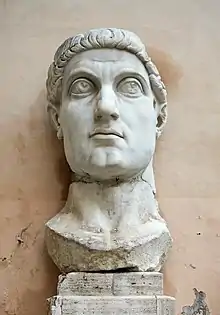 |
Constantine I "the Great" Κωνσταντῖνος ὁ Μέγας Fl. Valerius Constantinus |
25 July 306 – 22 May 337 (30 years, 9 months and 27 days) |
Born at Naissus c. 272 as the son of the Augustus Constantius and Helena. Proclaimed Augustus of the western empire upon the death of his father on 25 July 306, he became sole ruler of the western empire after the Battle of the Milvian Bridge in 312. In 324, he defeated the eastern Augustus Licinius and re-united the empire under his rule, reigning as sole emperor until his death. Constantine completed the administrative and military reforms begun under Diocletian, who had begun ushering in the Dominate period. Actively interested in Christianity, he played a crucial role in its development and the Christianization of the Roman world, through his convocation of the First Ecumenical Council at Nicaea. He is said to have received baptism on his deathbed. He also reformed coinage through the introduction of the gold solidus, and initiated a large-scale building program, crowned by the re-foundation the city of Byzantium as "New Rome", popularly known as Constantinople. He was regarded as the model of all subsequent Byzantine emperors.[6] |
.png.webp) |
Constantius II Κωνστάντιος Fl. Iulius Constantius |
22 May 337 – 3 November 361 (24 years, 1 month and 25 days) |
Born on 7 August 317, as the second surviving son of Constantine I, he inherited the eastern third of Roman Empire upon his father's death, sole Roman Emperor from 353, after the overthrow of the western usurper Magnentius. Constantius' reign saw military activity on all frontiers, and dissension between Arianism, favoured by the emperor, and the "Orthodox" supporters of the Nicene Creed. In his reign, Constantinople was accorded equal status to Rome, and the original Hagia Sophia was built. Constantius appointed Constantius Gallus and Julian as Caesares, and died on his way to confront Julian, who had risen up against him.[7] |
.png.webp) |
Julian "the Apostate" Ἰουλιανὸς ὁ Ἀποστάτης Fl. Claudius Iulianus |
3 November 361 – 26 June 363 (1 year, 7 months and 23 days) |
Born in May 332, grandson of Constantius Chlorus and cousin of Constantius II. Proclaimed by his army in Gaul, became legitimate Emperor upon the death of Constantius. Killed on campaign against Sassanid Persia. |
Non-dynastic (363–364) | |||
 |
Jovian Ἰοβιανός Claudius Iovianus[lower-alpha 2] |
27 June 363 – 17 February 364 (7 months and 21 days) |
Born c. 332. Captain of the guards under Julian, elected by the army upon Julian's death. Died on journey back to Constantinople. |
Valentinianic dynasty (364–379) | |||
.jpg.webp) |
Valentinian I Οὐαλεντινιανός Valentinianus |
26 February – 28 March 364 (1 month and 2 days) |
Born in 321. An officer under Julian and Jovian, he was elected by the army upon Jovian's death. He soon appointed his younger brother Valens as Emperor of the East, while he himself ruled in the West. Died of cerebral haemorrhage in 375. |
.png.webp) |
Valens Οὐάλης |
28 March 364 – 9 August 378 (14 years, 4 months and 12 days) |
Born in 328. A soldier of the Roman army, he was appointed Emperor of the East by his elder brother Valentinian I. Killed at the Battle of Adrianople. |
 |
Gratian Γρατιανός, Gratianus |
9 August 378 – 19 January 379 (5 months and 10 days) |
Born on 18 April/23 May 359, the son of Valentinian I. Emperor of the West, he inherited rule of the East upon the death of Valens and appointed Theodosius I as Emperor of the East. Assassinated on 25 August 383 during the rebellion of Magnus Maximus. |
Theodosian dynasty (379–457) | |||
.jpg.webp) |
Theodosius I "the Great" Θεοδόσιος ὁ Μέγας |
19 January 379 – 17 January 395 (15 years, 11 months and 29 days) |
Born on 11 January 347, in Spain. Aristocrat and military leader, brother-in-law of Gratian, who appointed him as emperor of the East. He reunited the whole Empire after defeating Eugenius at the Battle of the Frigidus, on 6 September 394. The last emperor to rule both halves of the Empire. |
.JPG.webp) |
Arcadius Ἀρκάδιος |
17 January 395 – 1 May 408 (13 years, 3 months and 14 days) |
Born in 377/378, the eldest son of Theodosius I; proclaimed Augustus on 16 January 383. On the death of Theodosius I in 395, the Roman Empire was permanently divided between the Eastern Roman Empire, later referred to as the Byzantine Empire, and the Western Roman Empire. Theodosius' eldest son Arcadius became emperor in the East while his younger son Honorius became emperor in the West. |
.jpg.webp) |
Theodosius II Θεοδόσιος |
1 May 408 – 28 July 450 (42 years, 2 months and 27 days) |
Born on 10 April 401, the only son of Arcadius; proclaimed Augustus on 10 January 402. Succeeded upon the death of his father. As a minor, the praetorian prefect Anthemius was regent in 408–414. He died in a riding accident. |
 |
Marcian Μαρκιανός, Marcianus |
25 August 450 – 27 January 457 (6 years, 5 months and 2 days) |
Born in 396. A soldier and politician, he became emperor after being wed by the Augusta Pulcheria, sister of Theodosius II, following the latter's death. Died of gangrene. |
Leonid dynasty (457–518) | |||
.jpg.webp) |
Leo I "the Great" and "the Butcher" Λέων ὁ Μέγας / Μακέλλης |
7 February 457 – 18 January 474 (16 years, 11 months and 11 days) |
Born in Dacia c. 400, and of Bessian origin, Leo became a low-ranking officer and served as an attendant of the Gothic magister militum, Aspar, who chose him as emperor on Marcian's death. He was the first emperor to be crowned by the Patriarch of Constantinople, and the first one to legislate in Greek.[8] His reign was marked by the pacification of the Danube and peace with Persia, which allowed him to intervene in the affairs of the West, supporting candidates for the throne and dispatching an expedition to recover Carthage from the Vandals in 468. Initially a puppet of Aspar, Leo began promoting the Isaurians as a counterweight to Aspar's Goths, marrying his daughter Ariadne to the Isaurian leader Tarasicodissa (Zeno). With their support, in 471 Aspar was murdered and Gothic power over the army was broken.[9] |
 |
Leo II "the Little" Λέων ὁ μικρός |
18 January – November 474 (10 months) |
Born 468, he was the grandson of Leo I by Leo's daughter Ariadne and her Isaurian husband, Zeno. He was raised to Augustus on 17 November 473. Leo ascended the throne after the death of his grandfather on 18 January 474. He crowned his father as co-emperor and effective regent on 29 January, dying shortly after. |
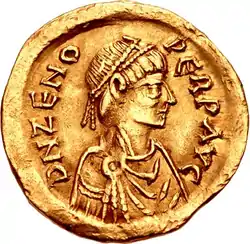 |
Zeno Ζήνων (Ταρασικοδίσσας) |
29 January 474 – 9 January 475 (11 months and 11 days) |
Born c. 425 in Isauria, originally named Tarasicodissa. As the leader of Leo I's Isaurian soldiers, he rose to comes domesticorum, married the emperor's daughter Ariadne and took the name Zeno, and played a crucial role in the elimination of Aspar and his Goths. He was named co-emperor by his son on 29 January 474 and became sole ruler upon the latter's death, but had to flee to his native country before Basiliscus in 475, regaining control of the capital in 476. Zeno concluded peace with the Vandals, saw off challenges against him by Illus and Verina, and secured peace in the Balkans by enticing the Ostrogoths under Theodoric the Great to migrate to Italy. Zeno's reign also saw the end of the western line of emperors. His pro-Monophysite stance made him unpopular and his promulgation of the Henotikon resulted in the Acacian Schism with the papacy.[10] |
 |
Basiliscus Βασιλίσκος |
9 January 475 – August 476 (1 year and 7 months) |
General and brother-in-law of Leo I, seized power from Zeno and crowned himself emperor on 12 January. Zeno was restored soon after. Died in 476/477 |
 |
Anastasius I "Dicorus" Ἀναστάσιος ὁ Δίκορος |
11 April 491 – 9 July 518 (27 years, 2 months and 28 days) |
Born c. 430 at Dyrrhachium, he was a palace official (silentiarius) when he was chosen as her husband and Emperor by Empress-dowager Ariadne. He was nicknamed "Dikoros" (Latin: Dicorus), because of his heterochromia. Anastasius reformed the tax system and the Byzantine coinage and proved a frugal ruler, so that by the end of his reign he left a substantial surplus. His Monophysite sympathies led to widespread opposition, most notably the Revolt of Vitalian and the Acacian Schism. His reign was also marked by the first Bulgar raids into the Balkans and by a war with Persia over the foundation of Dara. He died childless.[11] |
Justinian dynasty (518–602) | |||
 |
Justin I Ἰουστῖνος, Iustinus |
9 July 518 – 1 August 527 (9 years and 23 days) |
Born c. 450 at Bederiana (Justiniana Prima), Dardania. Officer and commander of the Excubitors bodyguard under Anastasius I, he was elected by army and people upon the death of Anastasius I. |
.jpg.webp) |
Justinian I "the Great" Ἰουστινιανὸς ὁ Μέγας Petrus Sabbatius Iustinianus |
1 August 527 – 14 November 565 (38 years, 7 months and 13 days) |
Born in 482/483 at Tauresium (Taor), Macedonia. Nephew of Justin I, raised to co-emperor on 1 April 527. Succeeded on Justin I's death. Attempted to restore the western territories of the Empire, reconquering Italy, North Africa and parts of Spain. Also responsible for the corpus juris civilis, or the "body of civil law," which is the foundation of law for many modern European nations.[12] |
.jpg.webp) |
Justin II Ἰουστῖνος, Iustinus |
14 November 565 – 5 October 578 (12 years, 10 months and 21 days) |
Born c. 520. Nephew of Justinian I, he seized the throne on the death of Justinian I with support of army and Senate. Became insane, hence in 573–574 under the regency of his wife Sophia, and in 574–578 under the regency of Tiberius Constantine. |
.jpg.webp) |
Tiberius II Constantine Τιβέριος Κωνσταντῖνος Tiberius Constantinus |
5 October 578 – 14 August 582 (3 years, 10 months and 19 days) |
Born c. 535, commander of the Excubitors, friend and adoptive son of Justin. Was named Caesar and regent in 574. Succeeded on Justin II's death. |
.png.webp) |
Maurice Μαυρίκιος Τιβέριος Mauricius Tiberius |
14 August 582 – 27 November 602 (20 years, 3 months and 14 days) |
Born in 539 at Arabissus, Cappadocia. Became an official and later a general. Married the daughter of Tiberius II and was proclaimed emperor on 13 August 582. Named his son Theodosius as co-emperor in 590. Deposed by Phocas and executed on 27 November 602 at Chalcedon. |
Non-dynastic (602–610) | |||
.jpg.webp) |
Phocas Φωκᾶς, Focas |
23 November 602 – 5 October 610 (7 years, 10 months and 12 days) |
Subaltern in the Balkan army, he led a rebellion that deposed Maurice. Increasingly unpopular and tyrannical, he was deposed and executed by Heraclius. |
Heraclian dynasty (610–695) | |||
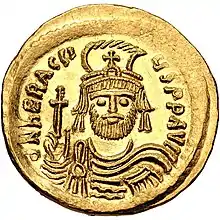 |
Heraclius Ἡράκλειος |
5 October 610 – 11 February 641 (30 years, 4 months and 6 days) |
Born c. 575 as the eldest son of the Exarch of Africa, Heraclius the Elder. Began a revolt against Phocas in 609 and deposed him in October 610. Brought the Byzantine-Sassanid War of 602–628 to successful conclusion but was unable to stop the Muslim conquest of Syria. Replaced Latin with Greek as the official language of administration in the East.[13][lower-alpha 3] |
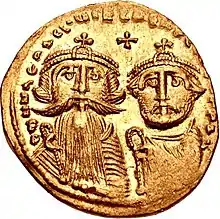 |
Heraclius Constantine[lower-alpha 4] Ἡράκλειος νέος Κωνσταντῖνος Heraclius novus Constantinus |
11 February – 25 May 641 (3 months and 14 days) |
Born on 3 May 612 as the eldest son of Heraclius by his first wife Fabia Eudokia. Named co-emperor on 22 January 613, he succeeded to throne with his younger brother Heraklonas following the death of Heraclius. Died of tuberculosis, allegedly poisoned by Empress-dowager Martina. |
.png.webp) |
Heraclonas Ἡρακλεωνᾶς, Heraclius |
11 February – c. 5 November 641 (8 months and 25 days) |
Born in 626 to Heraclius' second wife Martina, named co-emperor on 4 July 638. Succeeded to throne with Constantine III following the death of Heraclius. Sole emperor after the death of Constantine III, under the regency of Martina, but was forced to name Constans II co-emperor by the army, and was deposed by the Senate in September 641 (or early 642). |
 |
Constans II "the Bearded" Ἡράκλειος Κωνσταντῖνος (Κώνστας) Heraclius Constantinus (Constans) |
c. 5 November 641 – 15 July 668 (26 years and 10 months) |
Born on 7 November 630, the son of Constantine III. Raised to co-emperor in summer 641 after his father's death due to army pressure, he became sole emperor after the forced abdication of his uncle Heraklonas. Baptized Heraclius, he reigned as Constantine. "Constans" is his nickname. Moved his seat to Syracuse, where he was assassinated, possibly on the orders of Mizizios. |
_(2).png.webp) |
Constantine IV "the Younger" Κωνσταντῖνος ὁ νέος Constantinus |
September 668 – c. 10 July 685 (16 years and 10 months) |
Born in 652, co-emperor since 13 April 654, he succeeded following the murder of his father Constans II. Erroneously called "Constantine the Bearded" by historians through confusion with his father. He called the Third Council of Constantinople which condemned the heresy of Monothelitism, repelled the First Arab Siege of Constantinople, and died of dysentery. |
.png.webp) |
Justinian II "the Slit-nosed" Ἰουστινιανὸς ὁ Ῥινότμητος Iustinianus (first reign) |
c. 10 July 685 – 695
(10 years) |
Born in 669, son of Constantine IV, he was named co-emperor in 681 and became sole emperor upon Constantine IV's death. Deposed by military revolt in 695, mutilated (hence his surname) and exiled to Cherson, whence he recovered his throne in 705. |
Twenty Years' Anarchy (695–717) | |||
 |
Leontius Λεόντιος |
695 – 698
(3 years) |
General from Isauria, he deposed Justinian II and was overthrown in another revolt in 698. He was executed in February 706. |
 |
Tiberius III (Apsimarus) Τιβέριος (Ἀψίμαρος) |
698 – 705
(7 years) |
Admiral of Germanic origin, originally named Apsimar. He rebelled against Leontius after a failed expedition. Reigned under the name of Tiberius until deposed by Justinian II in 705. Executed in February 706. |
.jpg.webp) |
Justinian II "the Slit-nosed" (second reign) |
c. 21 August 705 – 4 November 711 (6 years, 2 months and 14 days) |
Returned on the throne with Bulgar support. Named son Tiberius as co-emperor in 706. Deposed and killed by military revolt. |
 |
Philippicus (Bardanes) Φιλιππικός (Βαρδάνης) Filepicus |
4 November 711 – 3 June 713 (1 year, 6 months and 30 days) |
A general of Armenian origin, he deposed Justinian II and was in turn overthrown by a revolt of the Opsician troops. |
 |
Anastasius II Ἀρτέμιος Ἀναστάσιος Artemius Anastasius |
4 June 713 – late 715 (less than 2 years) |
Originally named Artemios. A bureaucrat and secretary under Philippicus, he was raised to the purple by the soldiers who overthrew Philippicus. Deposed by another military revolt, he led an abortive attempt to regain the throne in 718 and was killed. |
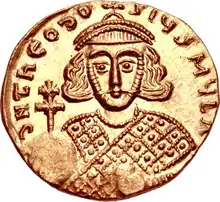 |
Theodosius III Θεοδόσιος |
late 715 – 25 March 717 (less than 2 years) |
A fiscal official, he was proclaimed emperor by the rebellious Opsician troops. Entered Constantinople in November 715. Abdicated following the revolt of Leo the Isaurian and became a monk. |
Isaurian dynasty (717–802) | |||
 |
Leo III "the Isaurian" Λέων ὁ Ἴσαυρος |
25 March 717 – 18 June 741 (24 years, 2 months and 24 days) |
Born c. 685 in Germanikeia, Commagene, he became a general. Rose in rebellion and secured the throne in spring 717. Repelled the Second Arab Siege of Constantinople and initiated the Byzantine Iconoclasm. |
.jpg.webp) |
Constantine V "the Dung-named" Κωνσταντῖνος Κοπρώνυμος |
18 June 741 – 14 September 775 (34 years, 2 months and 27 days) |
Born in July 718, the only son of Leo III. Co-emperor since 720, he succeeded upon his father's death. After overcoming the usurpation of Artabasdos, he continued his father's iconoclastic policies and won several victories against the Arabs and the Bulgars. He is given the surname "the Dung-named" by hostile later chroniclers. |
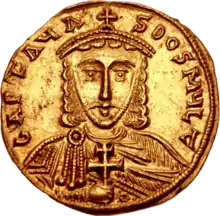 |
Artabasdos Ἀρτάβασδος |
June 741 – 2 November 743 (2 years and 5 months) |
General and son-in-law of Leo III, Count of the Opsician Theme. Led a revolt that secured Constantinople, but was defeated and deposed by Constantine V, who blinded and tonsured him. |
 |
Leo IV "the Khazar" Λέων ὁ Χάζαρος |
14 September 775 – 8 September 780 (4 years, 11 months and 25 days) |
Born on 25 January 750 as the eldest son of Constantine V. Co-emperor since 751, he succeeded upon his father's death. |
 |
Constantine VI Κωνσταντῖνος |
8 September 780 – 19 August 797 (16 years, 11 months and 11 days) |
Born in 771, the only child of Leo IV. Co-emperor since 14 April 776, sole emperor upon Leo's death in 780, until 790 under the regency of his mother, Irene of Athens. He was overthrown on Irene's orders, blinded and imprisoned, probably dying of his wounds shortly after. |
 |
Irene Εἰρήνη |
19 August 797 – 31 October 802 (5 years, 2 months and 12 days) |
Born c. 752 in Athens, she married Leo IV on 3 November 768 and was crowned empress on 17 December. Regent for her son Constantine VI in 780–790, she overthrew him in 797 and became empress-regnant. In 787 she called the Second Council of Nicaea which condemned the practice of iconoclasm and restored the veneration of icons to Christian practice. Deposed in a palace coup in 802, she was exiled and died on 9 August 803. |
Nikephorian dynasty (802–813) | |||
 |
Nikephoros I "Genikos" or "the Logothete" Νικηφόρος ὁ Γενικός/ὁ Λογοθέτης |
31 October 802 – 26 July 811 (8 years, 8 months and 26 days) |
Logothetes tou genikou (general finance minister) under Irene, led initially successful campaigns against the Bulgars but was killed at the Battle of Pliska. |
.png.webp) |
Staurakios Σταυράκιος |
26 July 811 – 2 October 811 (2 months and 4 days) |
Only son of Nikephoros I, crowned co-emperor in December 803. Succeeded on his father's death; however, he had been heavily wounded at Pliska and left paralyzed. He was forced to abdicate, and retired to a monastery where he died soon after. |
 |
Michael I Rangabe Μιχαὴλ Ῥαγγαβέ |
2 October 811 – 11 July 813 (1 year, 9 months and 9 days) |
Son-in-law of Nikephoros I, he succeeded Staurakios on his abdication. Resigned after the revolt under Leo the Armenian and retired to a monastery, where he died on 11 January 844. Reigned with eldest son Theophylact as co-emperor. |
Non-dynastic (813–820) | |||
 |
Leo V "the Armenian" Λέων ὁ Ἀρμένιος |
11 July 813 – 25 December 820 (7 years, 5 months and 14 days) |
General of Armenian origin, born c. 755. He rebelled against Michael I and became emperor. Appointed his son Symbatios co-emperor under the name of Constantine in 813. Revived Byzantine Iconoclasm. Murdered by a conspiracy led by Michael the Amorian. |
Amorian dynasty (820–867) | |||
 |
Michael II "the Amorian" Μιχαὴλ ὁ ἐξ Ἀμορίου |
25 December 820 – 2 October 829 (8 years, 9 months and 7 days) |
Born in 770 at Amorium, he became an army officer. A friend of Leo V, he was raised to high office but led the conspiracy that murdered him. Survived the rebellion of Thomas the Slav, lost Crete to the Arabs and faced the beginning of the Muslim conquest of Sicily, reinforced iconoclasm. |
.jpg.webp) |
Theophilos Θεόφιλος |
2 October 829 – 20 January 842 (12 years, 3 months and 18 days) |
Born in 813, as the only son of Michael II. Crowned co-emperor on 12 May 821, he succeeded on his father's death. |
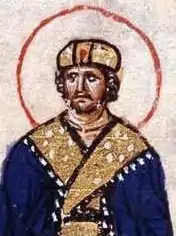 |
Michael III "the Drunkard" Μιχαὴλ ὁ Μέθυσος |
20 January 842 – 24 September 867 (25 years, 8 months and 4 days) |
His precise date of birth is uncertain, but the balance of available evidence supports a birthdate in January 840. The son of Theophilos, he succeeded on Theophilos' death. Under the regency of his mother Theodora until 856, and under the effective control of his uncle Bardas in 862–866. Ended iconoclasm. Murdered by Basil the Macedonian. A pleasure-loving ruler, he was nicknamed "the Drunkard" by later, pro-Basil chroniclers. |
Macedonian dynasty (867–1056) | |||
 |
Basil I "the Macedonian" Βασίλειος ὁ Μακεδών |
24 September 867 – 29 August 886 (18 years, 11 months and 5 days) |
Born in the Theme of Macedonia c. 811, he rose in prominence through palace service, becoming a favourite of Michael III, who crowned him co-emperor on 26 May 866. He overthrew Michael and established the Macedonian dynasty. He led successful wars in the East against the Arabs and the Paulicians, and recovered southern Italy for the Empire. |
.jpg.webp) |
Leo VI "the Wise" Λέων ὁ Σοφός |
29 August 886 – 11 May 912 (25 years, 8 months and 12 days) |
Born on 19 September 866, either the legitimate son of Basil I or the illegitimate son of Michael III. Co-emperor since 6 January 870. Leo was known for his erudition. His reign saw a height in Saracen (Muslim) naval raids, culminating in the Sack of Thessalonica, and was marked by unsuccessful wars against the Bulgarians under Simeon I. |
 |
Alexander Ἀλέξανδρος |
11 May 912 – 6 June 913 (1 year and 26 days) |
Son of Basil I, Alexander was born in 870 and raised to co-emperor in 879. Sidelined by Leo VI, Alexander dismissed his brother's principal aides on his accession. He died of exhaustion after a polo game. |
 |
Constantine VII Porphyrogenitus Κωνσταντῖνος ὁ Πορφυρογέννητος |
6 June 913 – 9 November 959 (46 years, 5 months and 3 days) |
Son of Leo VI, he was born on 17/18 May 905 and raised to co-emperor on 15 May 908. His early reign was dominated by successive regencies, first by his mother, Zoe Karbonopsina, and Patriarch Nicholas Mystikos, and from 919 by the admiral Romanos Lekapenos, who wedded his daughter to Constantine and was crowned senior emperor in 920. Constantine re-asserted his control by deposing Romanos's sons on 27 January 945. His reign was marked by struggles with Sayf al-Dawla in the East and an unsuccessful campaign against Crete, and pro-aristocratic policies that saw a partial reversal of Lekapenos' legislation against the dynatoi. He is notable for his promotion of the "Macedonian Renaissance", sponsoring encyclopaedic works and histories. He was a prolific writer himself, best remembered for the manuals on statecraft (De administrando imperio) and ceremonies (De ceremoniis) he compiled for his son.[14] |
 |
Romanos I Lekapenos Ῥωμανὸς Λεκαπηνός |
17 December 920 – 20 December 944 (24 years and 3 days) |
An admiral of lowly origin, Romanos rose to power as a protector of the young Constantine VII against the general Leo Phokas the Elder. After becoming the emperor's father-in-law, he successively assumed higher offices until he crowned himself senior emperor. His reign was marked by the end of warfare with Bulgaria and the great conquests of John Kourkouas in the East. Romanos promoted his sons Stephen and Constantine (alongside Christopher, who died soon after) as co-emperors over Constantine VII, but was himself overthrown by them and confined to an island as a monk. He died there on 15 June 948. |
.JPG.webp) |
Romanos II "the Purple-born" Ῥωμανὸς ὁ Πορφυρογέννητος |
9 November 959 – 15 March 963 (3 years, 4 months and 6 days) |
The only surviving son of Constantine VII, he was born on 15 March 938 and succeeded his father on the latter's death. He ruled until his own death, although the government was led mostly by the eunuch Joseph Bringas. His reign was marked by successful warfare in the East against Sayf al-Dawla and the recovery of Crete by general Nikephoros Phokas. |
.jpg.webp) |
Nikephoros II Phokas Νικηφόρος Φωκᾶς |
16 August 963 – 11 December 969 (6 years, 3 months and 25 days) |
The most successful general of his generation, Nikephoros II was born c. 912 to the powerful Phokas clan. After the death of Romanos II, he rose to the throne with the support of the army and people as regent for the young emperors Basil II and Constantine VIII, marrying the empress-dowager Theophano. Throughout his reign he led campaigns in the East, conquering much of Syria. He was murdered by his nephew and one-time associate John Tzimiskes. |
 |
John I Tzimiskes Ἰωάννης ὁ Τσιμισκὴς |
11 December 969 – 10 January 976 (6 years and 30 days) |
Nephew of Nikephoros Phokas, Tzimiskes was born c. 925. A successful general, he fell out with his uncle and led a conspiracy of disgruntled generals who murdered him. Tzimiskes succeeded Nikephoros as emperor and regent for the young sons of Romanos II. As ruler, Tzimiskes crushed the Rus' in Bulgaria and ended the Bulgarian tsardom before going on to campaign in the East, where he died. |
 |
Basil II "the Bulgar-Slayer" Βασίλειος ὁ Βουλγαροκτόνος |
10 January 976 – 15 December 1025 (49 years, 11 months and 5 days) |
Eldest son of Romanos II, Basil was born in 958. The first decade of his reign was marked by rivalry with the powerful Basil Lekapenos, an unsuccessful war against Bulgaria, and rebellions by generals in Asia Minor. Basil solidified his position through a marriage alliance with Vladimir I of Kiev, and after suppressing the revolts, he embarked on his conquest of Bulgaria. Bulgaria was finally subdued in 1018 after over 20 years of war, interrupted only by sporadic warfare in Syria against the Fatimid Caliphate. Basil also expanded Byzantine control over most of Armenia. His reign is widely considered as the apogee of medieval Byzantium. |
.jpg.webp) |
Constantine VIII Κωνσταντῖνος ὁ Πορφυρογέννητος |
15 December 1025– 12 November 1028
(2 years, 10 months and 28 days) |
The second son of Romanos II, Constantine was born in 960 and raised to co-emperor on 30 March 962. During the rule of Basil II, he spent his time in idle pleasure. During his short reign he was an indifferent ruler, easily influenced by his courtiers and suspicious of plots to depose him, especially among the military aristocracy, many of whom were blinded and exiled.[15] |
 |
Romanos III Argyros Ῥωμανὸς Ἀργυρός |
15 November 1028 – 11 April 1034 (5 years, 4 months and 30 days) |
Born in 968, the elderly aristocrat Romanos was chosen by Constantine VIII on his deathbed as Zoe's husband and succeeded on the throne after Constantine's death a few days later. |
.jpg.webp) |
Michael IV "the Paphlagonian" Μιχαὴλ ὁ Παφλαγών |
11 April 1034 – 10 December 1041 (7 years, 7 months and 28 days) |
Born in 1010, he became a lover of Zoe even while Romanos III was alive, and succeeded him upon his death as her husband and emperor. Aided by his older brother, the eunuch John the Orphanotrophos, his reign was moderately successful against internal rebellions, but his attempt to recover Sicily failed. He died after a long illness. |
 |
Michael V "the Caulker" Μιχαὴλ ὁ Καλαφάτης |
10 December 1041 – 20 April 1042 (4 months and 8 days) |
Born in 1015, he was the nephew and adopted son of Michael IV. During his reign he tried to sideline Zoe, but a popular revolt forced him to restore her as empress on 19 April 1042, along with her sister Theodora. He was deposed the next day, castrated and tonsured, dying on 24 August 1042. |
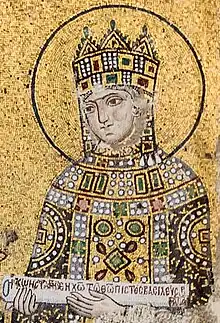 |
Zoe "the Purple-born" Ζωὴ ἡ Πορφυρογέννητος |
21 April – 12 June 1042 (1 month and 22 days) |
The daughter of Constantine VIII, she succeeded on her father's death, as the only surviving member of the Macedonian dynasty, along with her sister Theodora. Her three husbands, Romanos III (1028–1034), Michael IV (1034–1041) and Constantine IX (1042–1050) ruled alongside her. |
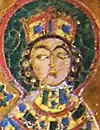 |
Theodora "the Purple-born" Θεοδώρα ἡ Πορφυρογέννητος |
21 April – 12 June 1042 (1 month and 22 days) (1 year, 7 months, 20 days) |
The younger sister of Zoe, born in 984, she was raised as co-ruler on 19 April 1042. After Zoe married her third husband, Constantine IX, in June 1042, Theodora was again sidelined. After Zoe died in 1050 and Constantine in 1055, Theodora assumed full governance of the Empire and reigned until her death. She nominated Michael VI as her successor. |
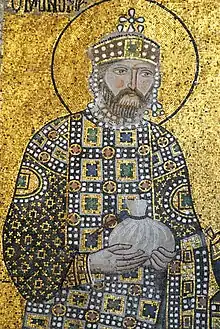 |
Constantine IX Monomachos Κωνσταντῖνος Μονομάχος |
12 June 1042 – 11 January 1055 (12 years, 6 months and 30 days) |
Born c. 1000 of noble origin, he had an undistinguished life but was exiled to Lesbos by Michael IV, returning when he was chosen as Zoe's third husband. Constantine supported the mercantile classes and favoured the company of intellectuals, thereby alienating the military aristocracy. A pleasure-loving ruler, he lived an extravagant life with his favourite mistresses and endowed a number of monasteries, chiefly the Nea Moni of Chios and the Mangana Monastery. His reign was marked by invasions by the Pechenegs in the Balkans and the Seljuk Turks in the East, the revolts of George Maniakes and Leo Tornikios, and the Great Schism between the patriarchates of Rome and Constantinople.[16] |
Non-dynastic (1056–1057) | |||
_(cropped).png.webp) |
Michael VI Bringas "Stratiotikos" / "the Old" Μιχαὴλ Βρίγγας ὁ Στρατιωτικός/ὁ Γέρων |
31 August 1056 – 30/31 August 1057 (1 year and 8 days) |
A court bureaucrat and stratiotikos logothetes (hence his first sobriquet). Crowned emperor by Theodora on 22 August 1056. Deposed by military revolt under Isaac Komnenos, he retired to a monastery where he died in 1059. |
Komnenid dynasty (1057–1059) | |||
.png.webp) |
Isaac I Komnenos Ἰσαάκιος Κομνηνός |
1 September 1057 – 22 November 1059 (2 years, 2 months and 21 days) |
Born c. 1005. A successful general, he rose in revolt leading the eastern armies and was declared emperor on 8 June 1057; he was recognized after the abdication of Michael. He resigned in 1059 and died c. 1061. |
Doukid dynasty (1059–1081) | |||
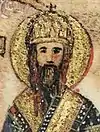 |
Constantine X Doukas Κωνσταντῖνος Δούκας |
23 November 1059 – 23 May 1067 (7 years and 6 months) |
Born in 1006, he became a general and close ally of Isaac Komnenos, and succeeded him as emperor on his abdication. Named his sons Michael, Andronikos and Konstantios as co-emperors. After his death his widow was regent until the accession of Romanus IV. |
_(cropped).png.webp) |
Romanos IV Diogenes Ῥωμανὸς Διογένης |
1 January 1068 – 1 October 1071 (3 years and 9 months) |
Born in 1032, a successful general he married empress-dowager Eudokia Makrembolitissa and became senior emperor as guardian of her sons by Constantine X. Deposed by the Doukas partisans after the Battle of Manzikert, blinded in June 1072 and exiled. He died soon after. |
.jpg.webp) |
Michael VII Doukas "Parapinakes" Μιχαὴλ Δούκας "Παραπινάκης" |
1 October 1071 – 24 March 1078 (6 years, 5 months and 23 days) |
Born in 1050 as the eldest son of Constantine X. Co-emperor since 1059, he succeeded on his father's death. Due to his minority he was under the regency of his mother, Eudokia Makrembolitissa, in 1067–1068, and relegated to junior emperor under her second husband Romanos IV Diogenes in 1068–71. Senior emperor in 1071–78, he named his son Constantine co-emperor alongside his brothers. He abdicated before the revolt of Nikephoros Botaneiates, retired to a monastery and died c. 1090. His reign saw the devaluation of the Byzantine currency by 25%, hence his nickname "minus-a-quarter". |
.jpg.webp) |
Nikephoros III Botaneiates Νικηφόρος Βοτανειάτης |
27 March 1078 – 1 April 1081 (2 years, 11 months and 29 days) |
Born in 1001, he was the strategos of the Anatolic Theme. He was proclaimed emperor on 7 January and crowned on 27 March or 3 April. He weathered several revolts, but was overthrown by the Komnenos clan. He retired to a monastery where he died in the same year. |
Komnenid dynasty (1081–1185) | |||
 |
Alexios I Komnenos Ἀλέξιος Κομνηνός |
1 April 1081 – 15 August 1118 (37 years, 4 months and 14 days) |
Born in 1056, a nephew of Isaac I Komnenos. A distinguished general, he overthrew Nikephoros III. His reign was dominated by wars against the Normans and the Seljuk Turks, as well as the arrival of the First Crusade and the establishment of independent Crusader states. He retained Constantine Doukas as co-emperor until 1087 and named his eldest son John co-emperor in 1092. |
 |
John II Komnenos Ἰωάννης Κομνηνός |
15 August 1118 – 8 April 1143 (24 years, 7 months and 24 days) |
Born on 13 September 1087 as the eldest son of Alexios I. Co-emperor since 1092, he succeeded upon his father's death. His reign was focused on wars with the Turks. A popular, pious and frugal ruler, he was known as "John the Good". Named his eldest son Alexios co-emperor in 1122, but the son predeceased his father. |
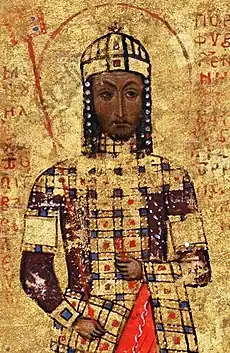 |
Manuel I Komnenos Μανουὴλ Κομνηνός |
8 April 1143 – 24 September 1180 (37 years, 5 months and 16 days) |
Born on 28 November 1118 as the fourth and youngest son of John II, he was chosen as emperor over his elder brother Isaac by his father on his deathbed. An energetic ruler, he launched campaigns against the Turks, humbled Hungary, achieved supremacy over the Crusader states, and tried unsuccessfully to recover Italy and Egypt. His extravagance and constant campaigning, however, depleted the Empire's resources. |
.png.webp) |
Alexios II Komnenos Ἀλέξιος Κομνηνός |
24 September 1180 – c. September 1183 (3 years) |
Born on 14 September 1169 as the only son of Manuel I. In 1180–1182 under the regency of his mother, Maria of Antioch. She was overthrown by Andronikos I Komnenos, who became co-emperor and finally had Alexios II deposed and killed. |
.png.webp) |
Andronikos I Komnenos Ἀνδρόνικος Κομνηνός |
c. September 1183 – 12 September 1185 (2 years) |
Born c. 1118, a nephew of John II by his brother Isaac. A general, he was imprisoned for conspiring against John II, but escaped and spent 15 years in exile in various courts in eastern Europe and the Middle East. He seized the regency from Maria of Antioch in 1182 and subsequently throne from his nephew Alexios II. An unpopular ruler, he was overthrown and lynched in a popular uprising. |
Angelid dynasty (1185–1204) | |||
.png.webp) |
Isaac II Angelos Ἰσαάκιος Ἄγγελος |
12 September 1185 – 8 April 1195 (9 years, 6 months and 27 days) |
Born in September 1156, Isaac came to the throne at the head of a popular revolt against Andronikos I. His reign was marked by revolts and wars in the Balkans, especially against a resurgent Bulgaria. He was deposed, blinded and imprisoned by his elder brother, Alexios III. He was later restored to the throne by the Crusaders and Alexios IV. Due to their failure to deal with the Crusaders' demands, he was deposed by Alexios V Doukas in January 1204 and died in January 1204, perhaps of poison. |
.png.webp) |
Alexios III Angelos Ἀλέξιος Ἄγγελος |
8 April 1195 – 18 July 1203 (8 years, 3 months and 10 days) |
Born in 1153, Alexios was the elder brother of Isaac II. His reign was marked by misgovernment and the increasing autonomy of provincial magnates. He was deposed by the Fourth Crusade and fled Constantinople, roaming Greece and Asia Minor, searching for support to regain his throne. He died in Nicaean captivity (confined to a monastery) in 1211. |
.png.webp) |
Alexios IV Angelos Ἀλέξιος Ἄγγελος |
19 July 1203 – 27 January 1204 (6 months and 8 days) |
Born in 1182, the son of Isaac II. He enlisted the Fourth Crusade to return his father to the throne, and reigned alongside his restored father from 19 July 1203. Due to their failure to deal with the Crusaders' demands, he was deposed by Alexios V Doukas in January 1204, and was strangled on 8 February. |
.png.webp) |
Alexios V Doukas "Mourtzouphlos" Ἀλέξιος Δούκας ὁ "Μούρτζουφλος" |
27 January 1204 – 12 April 1204 (2 months and 16 days) |
Born in 1140, the son-in-law of Alexios III and a prominent aristocrat, he deposed Isaac II and Alexios IV in a palace coup. He tried to repel the Crusaders, but they captured Constantinople forcing Mourtzouphlos to flee. He joined the exiled Alexios III, but was later blinded by the latter. Captured by the Crusaders, he was executed in December 1205. |
Laskarid dynasty (Empire of Nicaea, 1204–1261) | |||
.png.webp) |
Theodore I Laskaris Θεόδωρος Λάσκαρις |
May 1205 – November 1221 (16 years and 6 months) |
Born c. 1174, he rose to prominence as a son-in-law of Alexios III. His brother Constantine Laskaris (or Theodore himself, it is uncertain) was elected emperor by the citizens of Constantinople on the day before the city fell to the Crusaders; Constantine only remained for a few hours before the sack of the city and later fled to Nicaea, where Theodore organized the Greek resistance to the Latins. Proclaimed emperor after Constantine's death in 1205, Theodore was crowned only in Easter 1208. He managed to stop the Latin advance in Asia and to repel Seljuk attacks, establishing the Empire of Nicaea as the strongest of the Greek successor states. |
.png.webp) |
John III Vatatzes Ἰωάννης Βατάτζης |
December 1221 – 3 November 1254 (32 years and 11 months) |
Born c. 1192, he became the son-in-law and successor of Theodore I in 1212. A capable ruler and soldier, he expanded his state in Bithynia, Thrace and Macedonia at the expense of the Latin Empire, Bulgaria and the rival Greek state of Epirus. |
.png.webp) |
Theodore II Laskaris Θεόδωρος Λάσκαρις |
3 November 1254 – 16 August 1258 (3 years, 9 months and 13 days) |
Born in 1221/1222 as the only son of John III, he succeeded on his father's death. His reign was marked by his hostility towards the major houses of the aristocracy, and by his victory against Bulgaria and the subsequent expansion into and Albania. |
.png.webp) |
John IV Laskaris Ἰωάννης Λάσκαρις |
16 August 1258 – 25 December 1261 (3 years, 4 months and 9 days) |
Born on 25 December 1250 as the only son of Theodore II, he succeeded on his father's death. Due to his minority, the regency was exercised at first by George Mouzalon until his assassination, and then by Michael Palaiologos, who within months was crowned senior emperor. After the recovery of Constantinople in August 1261, Palaiologos sidelined John IV completely, had him blinded and imprisoned. John IV died c. 1305. |
Palaiologan dynasty (restored to Constantinople, 1261–1453) | |||
_(cropped).jpg.webp) |
Michael VIII Palaiologos Μιχαὴλ Παλαιολόγος |
1 January 1259 – 11 December 1282 (23 years, 11 months and 10 days) |
Born in 1223, great-grandson of Alexios III, grandnephew of John III by marriage. Senior emperor alongside John IV in 1259. His forces reconquered Constantinople on 25 July 1261, thus restoring the Empire. He entered the city and was crowned on 15 August. Became sole emperor after deposing John IV on 25 December 1261. |
 |
Andronikos II Palaiologos Ἀνδρόνικος Παλαιολόγος |
11 December 1282 – 24 May 1328 (45 years, 5 months and 13 days) |
Son of Michael VIII, born on 25 March 1259. Named co-emperor in 1261, crowned in 1272, he succeeded as sole emperor on Michael's death. Favouring monks and intellectuals, he neglected the army, and his reign saw the collapse of the Byzantine position in Asia Minor. He named his son Michael IX co-emperor. In a protracted civil war, he was first forced to recognize his grandson Andronikos III as co-emperor and was then deposed outright. He died on 13 February 1332. |
.png.webp) |
Michael IX Palaiologos Μιχαὴλ Παλαιολόγος |
21 May 1294 – 12 October 1320
(26 years, 4 months and 21 days) |
Son and co-ruler of Andronikos II, named co-emperor in 1281 but not crowned until 21 May 1294. Allegedly died of grief due to the accidental murder of his second son.[17] |
.jpg.webp) |
Andronikos III Palaiologos Ἀνδρόνικος Παλαιολόγος |
24 May 1328 – 15 June 1341 (13 years and 22 days) |
Son of Michael IX, he was born on 25 March 1297 and named co-emperor in 1316. Rival emperor since July 1321, he deposed his grandfather Andronikos II in 1328 and ruled as sole emperor until his death. Supported by John Kantakouzenos, his reign saw defeats against the Ottoman emirate but successes in Europe, where Epirus and Thessaly were recovered. |
.jpg.webp) |
John V Palaiologos Ἰωάννης Παλαιολόγος |
15 July 1341 – 12 August 1376 (35 years, 1 month and 28 days) |
Only son of Andronikos III, he had not been crowned or declared heir at his father's death, a fact which led to the outbreak of a destructive civil war between his regents and his father's closest aide, John VI Kantakouzenos, who was crowned co-emperor. The conflict ended in 1347 with Kantakouzenos recognized as senior emperor, but he was deposed by John V in 1354, during another civil war. Matthew Kantakouzenos, raised by John VI to co-emperor, was also deposed in 1357. John V appealed to the West for aid against the Ottomans, but in 1371 he was forced to recognize Ottoman suzerainty. |
.jpg.webp) |
John VI Kantakouzenos Ἰωάννης Καντακουζηνός |
8 February 1347– 10 December 1354
(7 years, 10 months and 2 days) |
A maternal relative of the Palaiologoi, he was declared co-emperor on 26 October 1341, and was recognized as senior emperor for ten years after the end of the civil war on 8 February 1347. Deposed by John V in 1354, he became a monk, dying on 15 June 1383. |
_(cropped).png.webp) |
Andronikos IV Palaiologos Ἀνδρόνικος Παλαιολόγος |
12 August 1376 – 1 July 1379 (2 years, 10 months and 19 days) |
Son of John V and grandson of John VI, he was born on 2 April 1348 and raised to co-emperor c. 1352. He deposed his father on 12 August 1376 and ruled until overthrown in turn in 1379. He was again recognized as co-emperor in 1381 and given Selymbria as an appanage, dying there on 28 June 1385. |
.jpg.webp) |
John V Palaiologos (second reign) |
1 July 1379 – 14 April 1390 (10 years, 9 months and 13 days) |
Restored to senior emperor, he was reconciled with Andronikos IV in 1381, re-appointing him co-emperor. He was overthrown again in 1390 by his grandson, John VII. |
.png.webp) |
John VII Palaiologos Ἰωάννης Παλαιολόγος |
14 April 1390 – 17 September 1390 (5 months and 3 days) |
Son of Andronikos IV, he was born in 1370, and named co-emperor under his father in 1377–79. He usurped the throne from his grandfather John V for five months in 1390, but with Ottoman mediation he was reconciled with John V and his uncle, Manuel II. As regent, he held Constantinople against the Ottomans in 1399–1402, and was then given Thessalonica as an appanage, which he governed until his death on 22 September 1408. |
.jpg.webp) |
John V Palaiologos (third reign) |
17 September 1390 – 16 February 1391 (4 months and 30 days) |
Restored to senior emperor, he ruled until his death in February 1391. |
.jpg.webp) |
Manuel II Palaiologos Μανουὴλ Παλαιολόγος |
16 February 1391 – 21 July 1425 (34 years, 4 months and 5 days) |
Second son of John V, he was born on 27 June 1350. Raised to co-emperor in 1373, he became senior emperor on John V's death and ruled until his death. He journeyed to the West European courts seeking aid against the Turks, and was able to use the Ottoman defeat in the Battle of Ankara to regain some territories and throw off his vassalage to them. |
 |
John VIII Palaiologos Ἰωάννης Παλαιολόγος |
21 July 1425 – 31 October 1448 (23 years, 4 months and 10 days) |
Eldest surviving son of Manuel II, he was born on 18 December 1392. Raised to co-emperor around 1416 and named full autokrator on 19 January 1421, he succeeded his father on his death. Seeking aid against the resurgent Ottomans, he ratified the Union of the Churches in 1439. |
.png.webp) |
Constantine XI Dragases Palaiologos Κωνσταντῖνος Δραγάσης Παλαιολόγος |
6 January 1449 – 29 May 1453 (4 years, 4 months and 23 days) |
The fourth son of Manuel II and Serbian princess Helena Dragaš, he was born on 8 February 1405. As Despot of the Morea since 1428, he distinguished himself in campaigns that annexed the Principality of Achaea and brought the Duchy of Athens under temporary Byzantine suzerainty, but was unable to repel Turkish attacks under Turahan Bey. As the eldest surviving brother, he succeeded John VIII after the latter's death. Facing the designs of the new sultan, Mehmed II, on Constantinople, Constantine acknowledged the Union of the Churches and made repeated appeals for help to the West, but in vain. Refusing to surrender the city, he was killed during the final Ottoman attack on 29 May 1453.[18] |
See also
- Family tree of Byzantine emperors
- List of Roman emperors
- List of Trapezuntine emperors
- List of Roman usurpers
- List of Byzantine usurpers
- Succession to the Byzantine Empire
- List of Roman and Byzantine empresses
- List of Byzantine emperors of Armenian origin
- Family tree of Roman emperors
- History of the Byzantine Empire
Notes
- ↑ Regnal numbers were never used in the Byzantine Empire. Instead, the Byzantines used nicknames and patronymics to distinguish rulers of the same name. The numbering of Byzantine emperors is a purely historiographical invention.
- ↑ By the 4th century, the name Flavius had become a part of the imperial title: Cameron, Alan (1988). "Flavius : a Nicety of Protocol". Société d'Études Latines de Bruxelles. 47 (1): 26–33. JSTOR 41540754.
- ↑ By this time Latin had long fallen out of everyday use in the Eastern part of the Empire.
- ↑ Often enumerated as Constantine III, whereby the regnal numbering follows Constantine II, emperor in the West (317–340). More rarely, he is instead enumerated as Heraclius II.
References
- 1 2 Nicol, Donald MacGillivray, Last Centuries of Byzantium, 1261–1453, Cambridge University Press, Second Edition, 1993, p. 72: "Hereditary succession to the throne was a custom or a convenience in Byzantium, not an inviolable principle. Emperors, particularly in the later period, would take pains to nominate their sons as co-emperors, for the rule of a dynasty made for stability and continuity. But in theory, the road to the throne was a carriere ouverte aux talents [career open to talents]..."
- ↑ Hooker, Richard (1 October 2007). "European Middle Ages: The Byzantine Empire". Washington State University. Archived from the original on 24 February 1999. Retrieved 25 August 2015.
- ↑ Charanis, Peter (July 1969). "Early Christian and Byzantine Political Philosophy: Origins and Background. Francis Dvornik". Speculum. 44 (3): 459–460. doi:10.2307/2855514. ISSN 0038-7134. JSTOR 2855514.
- ↑ Morrisson, Cécile (2013) "Displaying the Emperor's Authority and Kharaktèr on the Marketplace" in Armstrong, Pamela. Authority in Byzantium. Routledge. p. 72. ISBN 978-1409436089
- ↑ p. 183, Karayannopoulous, Yanis, "State Organization, Social Structure, Economy, and Commerce", History of Humanity – Scientific and Cultural Development from the Seventh to the Sixteenth Centuries, Vol. IV, M. A. Al-Bakhit, L. Bazin, S. M. Cissoko and M. S. Asimov, Editors, UNESCO, Paris (2000)
- ↑ Gregory, Timothy E.; Cutler, Anthony (1991). "Constantine I the Great". In Kazhdan, Alexander (ed.). The Oxford Dictionary of Byzantium. Oxford and New York: Oxford University Press. pp. 498–500. ISBN 0-19-504652-8.
- ↑ Gregory, Timothy E. (1991). "Constantius II". In Kazhdan, Alexander (ed.). The Oxford Dictionary of Byzantium. Oxford and New York: Oxford University Press. p. 524. ISBN 0-19-504652-8.
- ↑ Wickham, Christopher (2009). The inheritance of Rome. Penguin. p. 90. ISBN 9780670020980.
- ↑ Gregory, Timothy E.; Cutler, Anthony (1991). "Leo I". In Kazhdan, Alexander (ed.). The Oxford Dictionary of Byzantium. Oxford and New York: Oxford University Press. pp. 1206–1207. ISBN 0-19-504652-8.
- ↑ Gregory, Timothy E. (1991). "Zeno". In Kazhdan, Alexander (ed.). The Oxford Dictionary of Byzantium. Oxford and New York: Oxford University Press. p. 2223. ISBN 0-19-504652-8.
- ↑ Gregory, Timothy E. (1991). "Anastasios I". In Kazhdan, Alexander (ed.). The Oxford Dictionary of Byzantium. Oxford and New York: Oxford University Press. ISBN 0-19-504652-8.
- ↑ McKay/Hill, A History of World Societies. Bedford/St. Martin's, 9th edition. 2012
- ↑
- Norwich, John Julius (1988). Byzantium: The Early Centuries. Guild Publishing., p. 311
- ↑ Kazhdan, Alexander; Cutler, Anthony (1991). "Constantine VII Porphyrogennetos". In Kazhdan, Alexander (ed.). The Oxford Dictionary of Byzantium. Oxford and New York: Oxford University Press. pp. 502–503. ISBN 0-19-504652-8.
- ↑ Brand, Charles M.; Cutler, Anthony (1991). "Constantine VIII". In Kazhdan, Alexander (ed.). The Oxford Dictionary of Byzantium. Oxford and New York: Oxford University Press. pp. 503–504. ISBN 0-19-504652-8.
- ↑ Brand, Charles M.; Cutler, Anthony (1991). "Constantine IX Monomachos". In Kazhdan, Alexander (ed.). The Oxford Dictionary of Byzantium. Oxford and New York: Oxford University Press. p. 504. ISBN 0-19-504652-8.
- ↑ Talbot, Alice-Mary; Cutler, Anthony (1991). "Michael IX Palaiologos". In Kazhdan, Alexander (ed.). The Oxford Dictionary of Byzantium. Oxford and New York: Oxford University Press. pp. 1367–1368. ISBN 0-19-504652-8.
- ↑ Talbot, Alice-Mary (1991). "Constantine XI Palaiologos". In Kazhdan, Alexander (ed.). The Oxford Dictionary of Byzantium. Oxford and New York: Oxford University Press. p. 505. ISBN 0-19-504652-8.